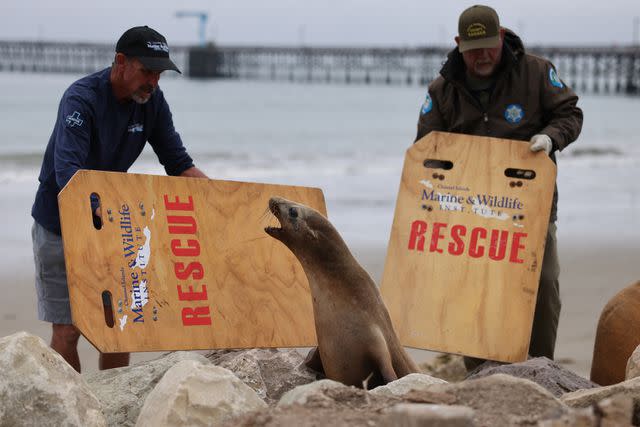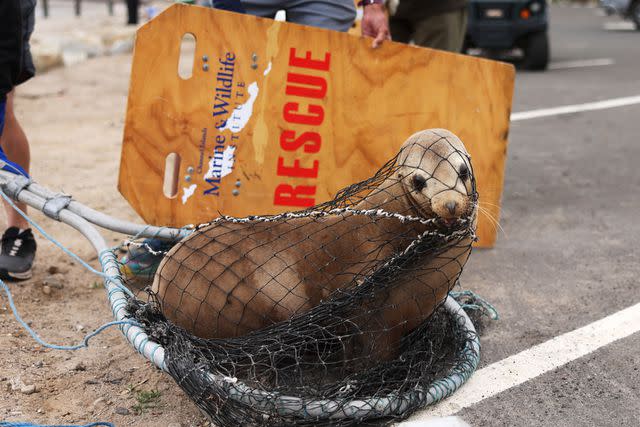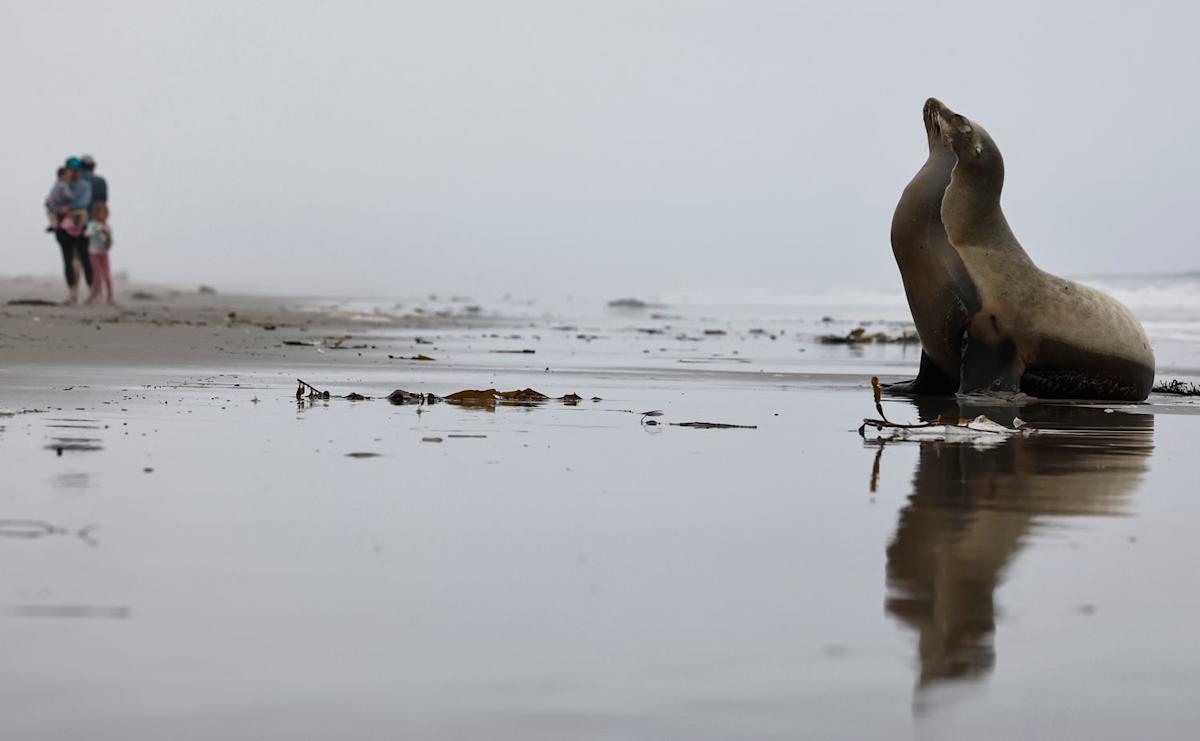-
Surfer Rj LaMendola said he was attacked a feral sea lion on March 21 in California. He later learned the animal had been affected by domoic acid, an algae-produced toxin
-
Symptoms for sea lions who eat prey contaminated with the toxin include such things as lethargy, disorientation, foaming at the mouth, erratic behavior, seizures and, in severe cases, death
-
“These animals are reacting to the fact that they are sick,” said John Warner, CEO of Los Angeles’ Marine Mammal Care Center
California sea lions usually appear as gregarious creatures toward humans, but that isn’t always the case.
When sea lions have been exposed to “domoic acid toxicity,” a byproduct of consuming toxic algae, afflicted animals can display unusual behaviors such as their “head swaying back and forth, foaming at the mouth or seizure activity,” according to the Channel Islands Marine and Wildlife Institute (CIMWI), based in Santa Barbara, Calif.
Rj LaMendola, a surfer, experienced the situation firsthand during an incident in Oxnard Shores with a sea lion facing domoic acid toxicity.
In a Facebook post, LaMendola recalled being attacked on March 21 by a very aggressive sea lion while out surfing by himself. The day started as a normal ordinary session when suddenly the animal hurtled toward him at full speed with its “mouth gaped wide, teeth flashing, and its eyes locked onto me with an unsettling ferocity.“
“My heart lurched as I instinctively yanked my board to the side, paddling frantically to evade it as it barreled forward, intent on crashing into me,” LaMendola wrote.
Then, when LaMendola thought the sea lion disappeared, the animal reemerged from the water and slammed into his board. The beach to the surfer was a distant speck and panic set in.
“Then I saw it again—another furious charge, this time more enraged than before. Its movements were erratic, wild, almost unhinged. I turned my board to face it, hoping to shield myself, splashing water and shouting in a desperate bid to scare it off. But it didn’t flinch. It kept coming, unstoppable, its jaws snapping closer,” LaMendola continued.
Related: Sea Lion Escapes Central Park Zoo Enclosure During New York City Flooding
LaMendola said the sea lion’s jaws clamped into his butt cheek and pierced through his wet suit. “The pain was sharp and immediate, but the terror was worse—it shook its head violently, tugging me off my board by my flesh, dragging me into the water,” he added.
“I don’t know how to describe the fear that gripped me in that moment. So far from shore, so helpless, staring into the face of this creature that looked like nothing I’d ever seen—its expression was feral, almost demonic, devoid of the curiosity or playfulness I’d always associated with sea lions,” LaMendola also noted.
The surfer used his board as a shield against the animal. He eventually made it to the beach and sought medical treatment while left still reeling from the ordeal.
When LaMendola later contacted the Channel Islands Marine and Wildlife Institute and told them what happened to him, he learned there had been a “wave of incidents” involving sea lions and other mammals who have been affected by domoic acid toxicity along Santa Barbara and Ventura County.

David Swanson/AFP/Getty
A sick California sea lion with possible domoic acid poisoning is rescued in Santa Barbara, Calif
LaMendola wasn’t the only person recently attacked by a sick sea lion. Swimmer Phoebe Beltran, 15, of Long Beach, said a sea lion injured her right arm on March 30, CNN affiliate KCAL reported.
“I was just so scared, so shocked, but I still felt the immense pain on my arms, like, over and over again,” Beltran, who sustained bites, bruises and scratches from the encounter, told the outlet.
According to CIMWI, domoic acid is a neurotoxin produced by the microscopic marine algae Pseudo-nitzschia australis.
Filter-feeders like small fish, shellfish and bivalves aren’t affected when they consume the toxic algae. But when sea lions, sea birds, dolphins and other predators eat the filter feeders, they are “negatively impacted,” said the institute.
Symptoms for sea lions who eat the contaminated prey include such things as lethargy, disorientation, foaming at the mouth, erratic behavior, seizures and, in severe cases, death.
John Warner, CEO of Los Angeles’ Marine Mammal Care Center told the BBC that the toxin affects the behavior of sea lions, which don’t usually attack people.

David Swanson/AFP/Getty
A sick California sea lion with possible domoic acid poisoning is rescued in Santa Barbara, Calif
“These animals are reacting to the fact that they are sick,” Warner said. “They’re disoriented, and most likely, most of them are having seizures, and so their senses are not all fully functional as they normally would and they’re acting out of fear.”
The CIMWI said it has been rescuing and rehabilitating marine mammals affected by the toxin. It reported that it responded to 262 animals suspected of having domoic acid in 2022. That number skyrocketed to 651 the following year.
Warner told the BBC that his Marine Mammal Care Center admitted about 195 sea lions from Feb 20 to the end of March. In comparison, the organization dealt with only 50 sea lions during the same time period in 2024.
Never miss a story — sign up for PEOPLE’s free daily newsletter to stay up-to-date on the best of what PEOPLE has to offer, from celebrity news to compelling human interest stories.
There is no known cure for domoic acid, said the CIMWI, but the animals can be treated and recover through “flushing the toxin from the animal’s body with subcutaneous fluids, administering anti-seizure medication if warranted … and feeding our patients fish that does not have the domoic acid toxin.”
Related: Baby Seal Found Alone on Busy Connecticut Street Being ‘Monitored Closely’ in Local Aquarium
As for humans encountering a sea lion displaying the symptoms associated with DA toxicity, the CIMWI recommends keeping a distance from the animal—at least a minimum of 50 feet
In his Facebook post, LaMedola said he considers himself lucky that he survived the recent sea lion attack but admitted he still can’t shake off the memory.
“If you’re out there on the water, especially around Santa Barbara or Ventura, please be cautious,” he wrote. ”This isn’t normal sea lion behavior — it’s something darker, something dangerous. I’m grateful to be alive … and back on solid ground, but I won’t be paddling out again anytime soon, unfortunately.”
Read the original article on People
